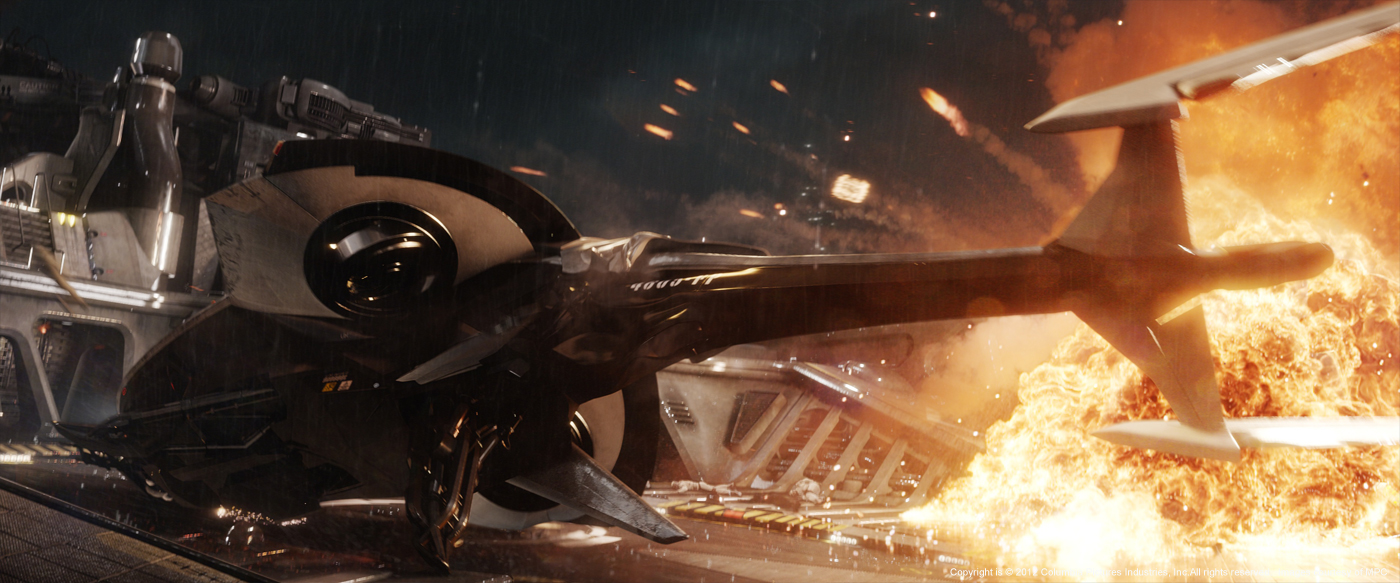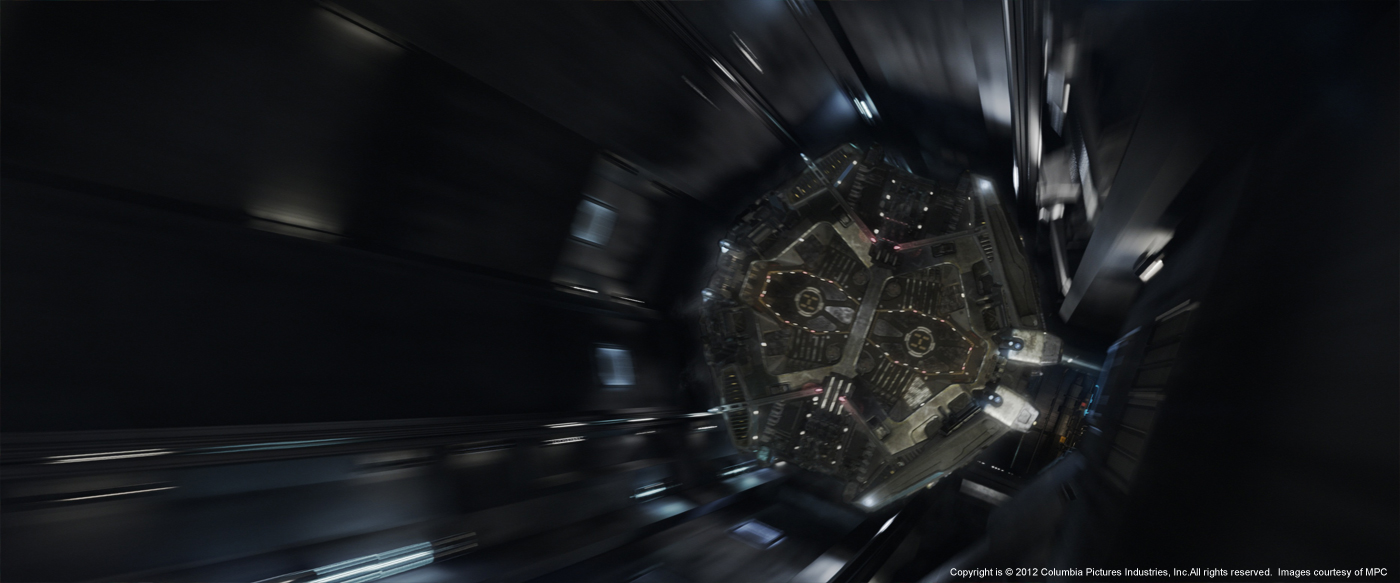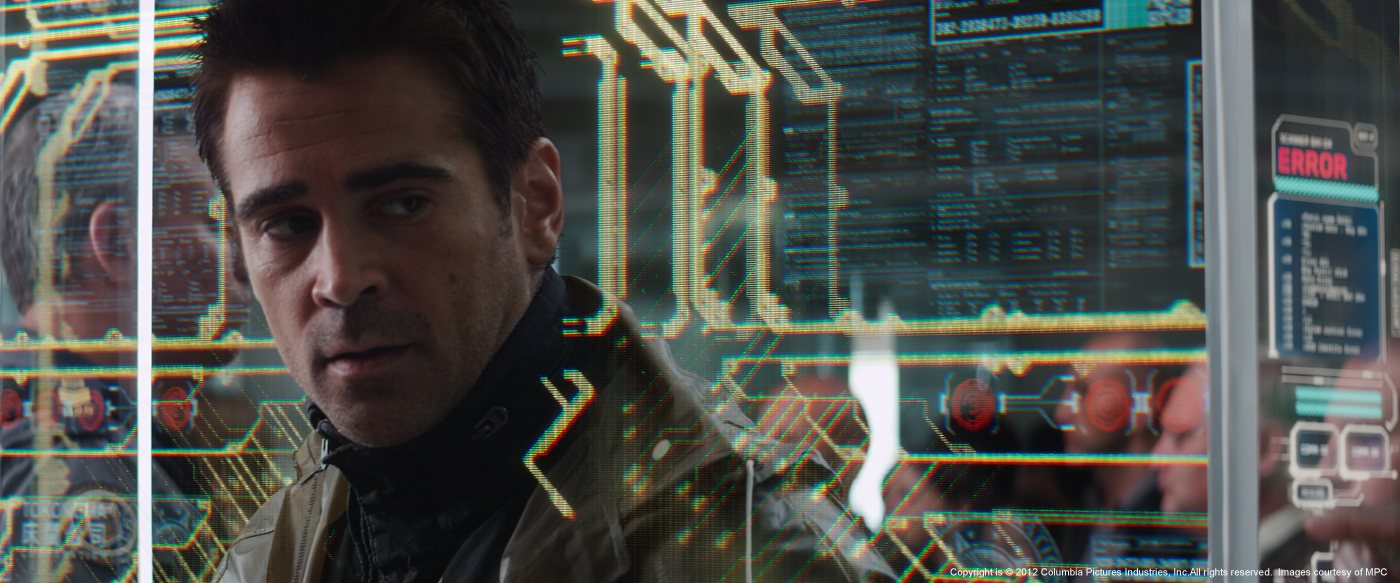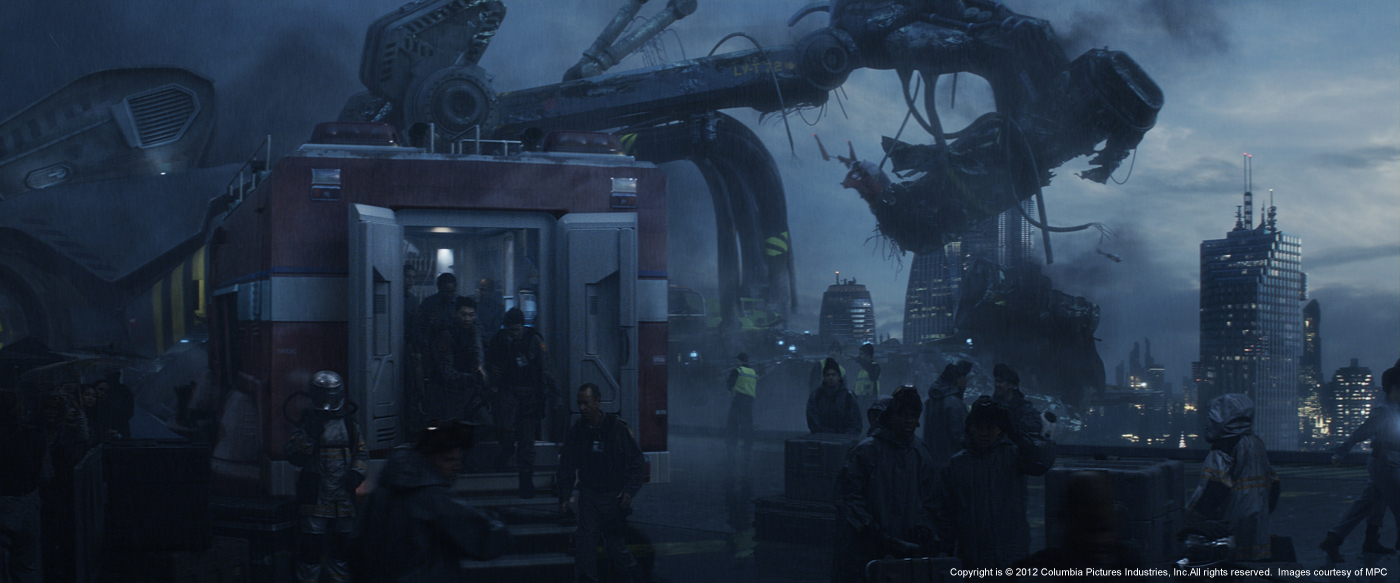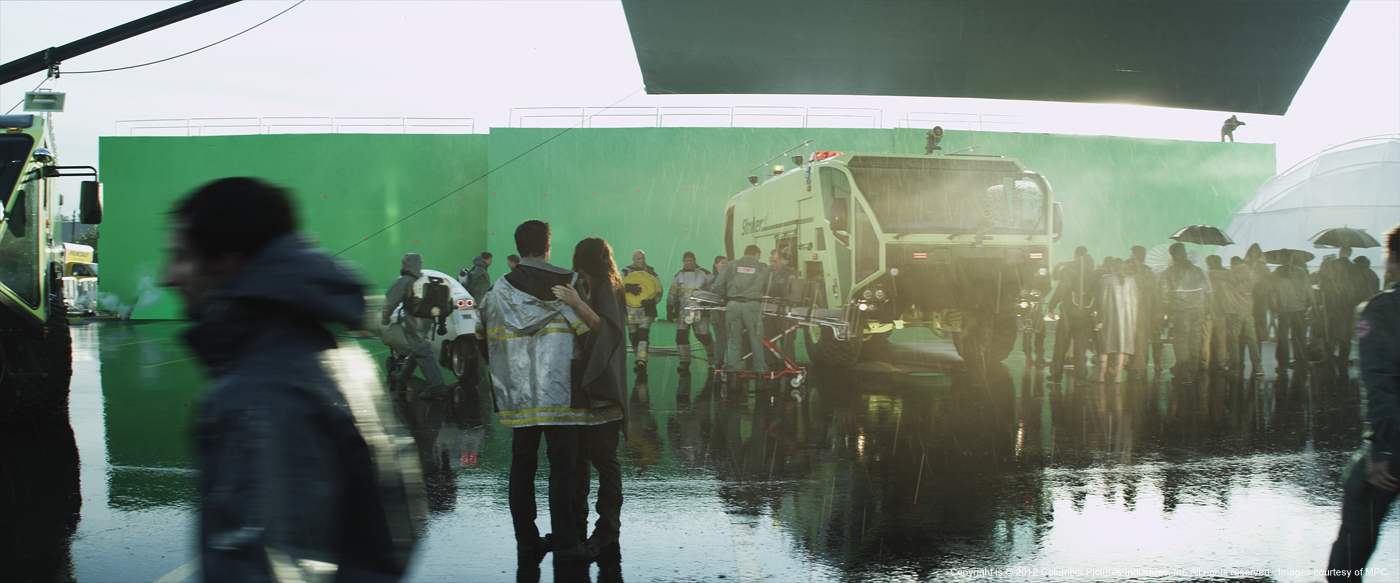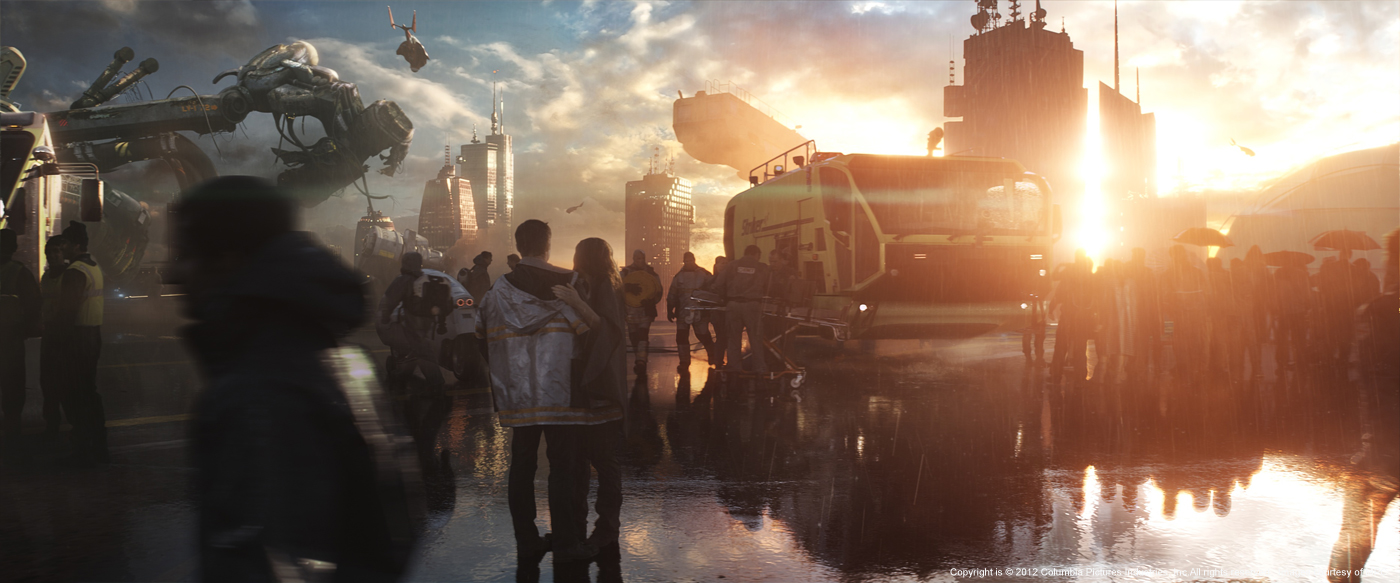After explaining the MPC work on PROMETHEUS, Charley Henley is back on The Art of VFX. It details his work on TOTAL RECALL.
How did MPC get involved on this show?
MPC joined the show in the last 6 weeks of post. At that time we had good resources available as we’d just completed PROMETHEUS and WRATH OF THE TITANS. We’ve worked extensively with VFX Supervisor Angus Bickerton in the past and as he was to supervise shots that weren’t done by the main vendor Double Negative.
How was the collaboration with director Len Wiseman and Production VFX Supervisor Peter Chiang?
Most evenings Angus Bickerton would do cinesync reviews with Len who was in LA. We’d send our WIP dailies through and get videoed feedback and drawings. Working from London with the west coast of America can be very efficient in this way as you can submit work at night and have feedback by the next morning, the artist comes in the next day with the Directors feedback for his shot. The video and drawings Len did on the shots also gave us a very direct link to Len’s ideas.
What have you done on this show?
MPC joined the show planning to do 30 or so simple sign and monitor replacements, but this quickly escalated to 120 shots including full CG tunnel and Fall shots, Full CG Helijet crash shots, the anti-cognition collar FX and the end scene which involved CG set-extension, Matt painting and CG vehicles.
Can you explain to us your work on The Fall and especially the zero G shots?
We did a collection of 12 or so all-CG shots where the Fall is traveling through the shaft from one side of the earth to the other. This included shots for the moment where the Fall reaches the center of the earth and it becomes a zero G environment. We used a model and base textures from Dneg for the tunnel, but it turned out to be quite time consuming to transfer the assets to MPC’s pipeline. On top of this we had to do a lot of look development for each shot, designing the lighting setup to show the scale, we also played a lot with speed and motion blur settings to get a convincing and interesting look to the tunnel walls as they wiz past camera. For shots where the camera is locked to the tunnel matte painters worked directly on the PRman rendered colour pass with the brief to add scale and realism, we projected details of dirt and added decals and service enclaves to the structure.
The model of the Fall was large and the tunnel moved fast showing a lot of geo to camera and so the early render times were too high. We had to save time on the fast moving shots to give us some design iterations so we baked some of the lighting in as a texture to get the overall look. We then ran a separate interaction pass with lights from the fall onto the wall and visa versa, Supervisor Marian Mavrovic’s Compositing team took these passes and combined them with the baked render and then created a sense of depth with atmosphere and, as the Fall gets closer to New Asia, FX rain and splashes. Fitting for Len’s style on the show we also added a lot of lens flares and effects such as and water on the lens diffraction.
How did you design the anti-cognition collar effect?
The idea is this collar projects a photorealistic holographic head of a preprogramed character around the wearer’s head; it’s a futuristic Spy’s mask. We did shots of the collar malfunctioning as Quaid walks through security. It starts flicking between the different heads in its memory, and then it breaks down completely and reveals Quaid.
A hero plate of Quaid was shot for real and then repeat performances for each character were filmed to roughly match Quaid’s original. We decided up front we needed total control over these elements, so after creating basic 3D models from scans each of the performers heads was roto-animated in 3D space. MPC Compositing Lead and Supervisor Axel Bonami then camera projected each live-action head onto the roto-animated CG head and unwrapped that to make an animated texture map, this effectively lined up all the performances perfectly and gave us a flat surface on which to map matrix textures and design the transitions on. All four heads blended together perfectly, and it looked convincingly three dimensional around the surface of the head, even though all the design work was controlled in 2D and done in Nuke. Noise and block patterns were created so that different parts of the four different heads would appear here and there which created a very interesting collage of all the different faces flicking around and mixing together. We wanted it to feel tangible and in the world and not just a graphic, so we incorporated some shadowing from one face to the next and blended this with an organic breakup to the blue digital mesh effect.
What references did you receive from production for this collar?
Some tests had been done for a trailer version before we started so that was the springboard. We ran a number of animation and texture tests till we found something Len liked the feel of, from then on it was just a matter of refinement.
Can you tell us more about the set extension for this sequence?
After Quaid and Lori fight within the ambulance, where MPC did a number of monitor inserts and an anti-cognition effect, Lori gets shot and we are out on top of the skyscraper and in the middle of the aftermath of the Falls destruction with Rescue services, Press and crowd all over the place. This scene was mostly shot on a green screen set with only the doors and interiors of ambulances built for real. We created the ambulances from scratch and added a lot of crowd using green screen elements production had shot. We added CG rescue-harriers flying around in the background and the odd hovering fire truck. The cityscape in the background was a Digital Matte Painting and for the mid ground a CG set extension lit and rendered to fit the DMP and set lighting, we added rain, rain splashes and smoke in compositing. To design the look of the scene there was also a lot of sky and grade development work needed to find the right type of light to convincingly integrate the interior shot sets into a digital exterior.
How did you create the clamps explosions?
For explosions we used Real elements mostly. We animated CG pieces flying and exploding debris and integrated them into real fire explosions elements that were carefully choreographed to match previs.
This sequence ends with lots of ambulance and crowd. Can you tell us more about the ambulances creation?
For the wide angle shots we modeled and textured to a relatively low level of detail and then we used a Matte Painted pass, based on real photography of metal bumpers, tail lights and dirt, to increase the quality of the textures for the close up shots. Comp then combined the best of a lighting pass, mostly reflections and shading, with this projected Matte Painted pass and created animated flashing lights.
How did you collaborate with the Double Negative teams for the asset?
We had a direct phone line to DNeg over the first few weeks as they scripted us a road map for the tagging of their textures, this was needed to help in converting their assets to MPC’s pipeline. They are only round the corner from out London facility so our CG supervisors Sheldon Stopsack and Max Wood met up with their counterparts when needed. The assets were huge and it was actually quite a time consuming process, good communication really helped.
The movie wraps up with newsreel footages of people cheering. How did you create those shots?
In a rough cut we had as a guide, Len had cut in some footage from helicopter views of news footage with crowds gathering, our challenge was to capture this mood and do a version representing downtown New Asia after The Fall had been blown-up and everybody is cheering in the streets. We had to find the most efficient approach to get something photo-real in the short space of time, generated effectively from scratch. We started by creating some very basic models for the ground level of the Colony using photography of the set, with this we blocked out the CG camera’s, later extending it to create a downtown area with waterways and boats. Rather than going fully through a texturing and lighting pipeline we did a hybrid Matte Painting and lighting approach only rendering a basic lighting pass for reflections and water interaction. Compositing Supervisor Marian Mavrovic set-up a 2 1/2D approach to creating the crowd. We needed close up and wide views of photo real people, we shot elements of about 20 people in various costumes, doing different performances. To layout the crowd we used our property CG crowd tool Alice, this gave us the numbers and enabled us to do iterations of crowd density and positions with Angus and Len. Once the layout was locked we wrote a tool to export the Alice positions to cards in Nuke, to which the crowd elements were attached, then we could dial in different parts of the performances to taste. Rain, atmosphere and lens effects were added in compositing.
What was the biggest challenge on this project and how did you achieve it?
The biggest challenge was dealing with the tight timeline. We had six weeks to complete, which included getting all the assets shot ready.
To get through all the set-up work we divided up all the issues so we could tackle everything in parallel. We pushed a lot of WIP work through the pipeline to make sure all the team was working on the shots as soon as possible and we didn’t have anyone waiting for the department before them to finish.
Was there a shot or a sequence that prevented you from sleep?
The bid CG tunnel shots took a long time to get shot ready, meaning we couldn’t even see a test lighting render for weeks as the asset for the Fall was so big and there was so much transferring work to do.
What do you keep from this experience?
I realized what a great luxury it is to have decent prep time, something missing on this show! But also how much great work can be done quickly with a strong team. It was a pleasure to work so intensely with a very talented crew.
How long have you worked on this film?
6 weeks.
How many shots have you done?
120 shots.
What was the size of your team?
Crew of just over 100 were involved at some point over the 6 weeks.
A big thanks for your time.
// WANT TO KNOW MORE?
– MPC: Dedicated page about TOTAL RECALL on MPC website.
© Vincent Frei – The Art of VFX – 2012


